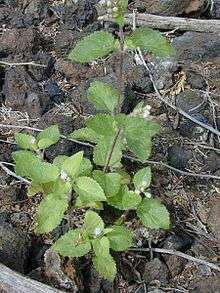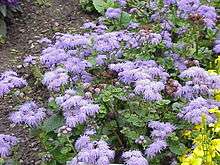Ageratum
| Ageratum | |
|---|---|
 | |
| Tropical Whiteweed (Ageratum conyzoides) | |
| Scientific classification | |
| Kingdom: | Plantae |
| (unranked): | Angiosperms |
| (unranked): | Eudicots |
| (unranked): | Asterids |
| Order: | Asterales |
| Family: | Asteraceae |
| Subfamily: | Asteroideae |
| Tribe: | Eupatorieae |
| Genus: | Ageratum L. 1753 not Mill. 1754 (Plantaginaceae)[1] |

Ageratum (/əˈdʒɛrətəm/),[2] (whiteweed in the USA), is a genus of 40[3] to 60 tropical and warm temperate flowering annuals and perennials from the family Asteraceae, tribe Eupatorieae. Most species are native to Central America and Mexico but four are native to the United States.[3]
They form tussocks or small hills. They grow to a height of 30 in. The opposite leaves are cordate or oval, hairy or tomentose. The margins are slightly toothed or serrate. The leaves form compact clusters.
The fluffy flowers are lavender-blue, pink, lilac, or white; and spread in small compound umbels. They give small, dry fruits.
Cultivation
Ageratums are grown for their flowers, especially A. houstonianum.
Most common ageratums, "Hawaii" for example, are a short 6-8 inches when full grown. Tall ageratum are also available in seed catalogues. They are about 18 inches in height with blue flowers. There is also a medium height snowcapped variety, white top on blue flowers. The blues are most popular and common, but colors also include violet, pink and white. Their size and color makes ageratums good candidates for rock gardens, bedding, and containers. They grow well in sun or partial shade, from early summer to first frost. They are quite easy to grow, producing a profusion of fluffy flowers all season long.
Toxicity
Several species of Ageratum are toxic, containing pyrrolizidine alkaloids. Ageratum houstonianum and Ageratum conyzoides cause liver lesions and are tumorigenic.[4][5][6][7]
Weed risk
Ageratum are prone to becoming rampant environmental weeds when grown outside of their natural range.[8][9]
Species
- accepted species
- Ageratum albidum
- Ageratum altissima
- Ageratum anisochroma
- Ageratum ballotifolium
- Ageratum candidum
- Ageratum chiriquense
- Ageratum chortianum
- Ageratum conyzoides
- Ageratum corymbosum
- Ageratum echioides
- Ageratum elassocarpum
- Ageratum ellepticum
- Ageratum fastigiatum
- Ageratum gaumeri
- Ageratum guatemalense
- Ageratum hondurense
- Ageratum houstonianum
- Ageratum isocarphoides
- Ageratum lavenia
- Ageratum littorale
- Ageratum lucidum
- Ageratum lundellii
- Ageratum maritimum
- Ageratum meridanum
- Ageratum microcarpum
- Ageratum microcephalum
- Ageratum molinae
- Ageratum munaense
- Ageratum myriadenium
- Ageratum nelsonii
- Ageratum oerstedii
- Ageratum oliveri
- Ageratum paleaceum
- Ageratum panamense
- Ageratum peckii
- Ageratum petiolatum
- Ageratum platylepis
- Ageratum platypodum
- Ageratum pohlii
- Ageratum radicans
- Ageratum riparium
- Ageratum rugosum
- Ageratum salicifolium
- Ageratum salvanaturae
- Ageratum scorpioideum
- Ageratum solisii
- Ageratum stachyofolium
- Ageratum standleyi
- Ageratum tehuacanum
- Ageratum tomentosum
Segregate genera
The genus Paneroa consists of one species, Paneroa stachyofolia, native to Oaxaca, which was first described in Ageratum but which seems to be more closely related to Conoclinium and Fleischmannia.[10]
References
- ↑ Tropicos, search for Ageratum
- ↑ Sunset Western Garden Book, 1995:606–607
- 1 2 "Ageratum". Flora of North America.
- ↑ Acamovic, T., Stewart, C.S., Pennycott, T.W.,"Poisonous Plants and Related Toxins", 2004
- ↑ Noa, M., Sanchez, L.M., Durand, R., "Ageratum houstonianum toxicosis in Zebu cattle", Veterinary and human toxicology, 2004, vol.46, no4, pp.193-195.
- ↑ Sani, Y., Bahri, S., "Pathological changes in liver due to the toxicity of Ageratum conyzoides", Penyakit Hewan (Indonesia), 1994, v. 26(48) p. 64-70
- ↑ Fu, P.P., Yang, Y.C., Xia, Q., Chou, M.C., Cui, Y.Y., Lin G., "Pyrrolizidine alkaloids-tumorigenic components in Chinese herbal medicines and dietary supplements", Journal of Food and Drug Analysis, Vol. 10, No. 4, 2002, pp. 198-211
- ↑ Global Compendium of Weeds, Ageratum conyzoides (Asteraceae)
- ↑ Global Compendium of Weeds, Ageratum houstonianum (Asteraceae)
- ↑ Schilling, Edward E. (2008). "Paneroa, A New Genus of Eupatorieae (Asteraceae) from Mexico". Novon a Journal for Botanical Nomenclature. 18 (4): 520. doi:10.3417/2007173.